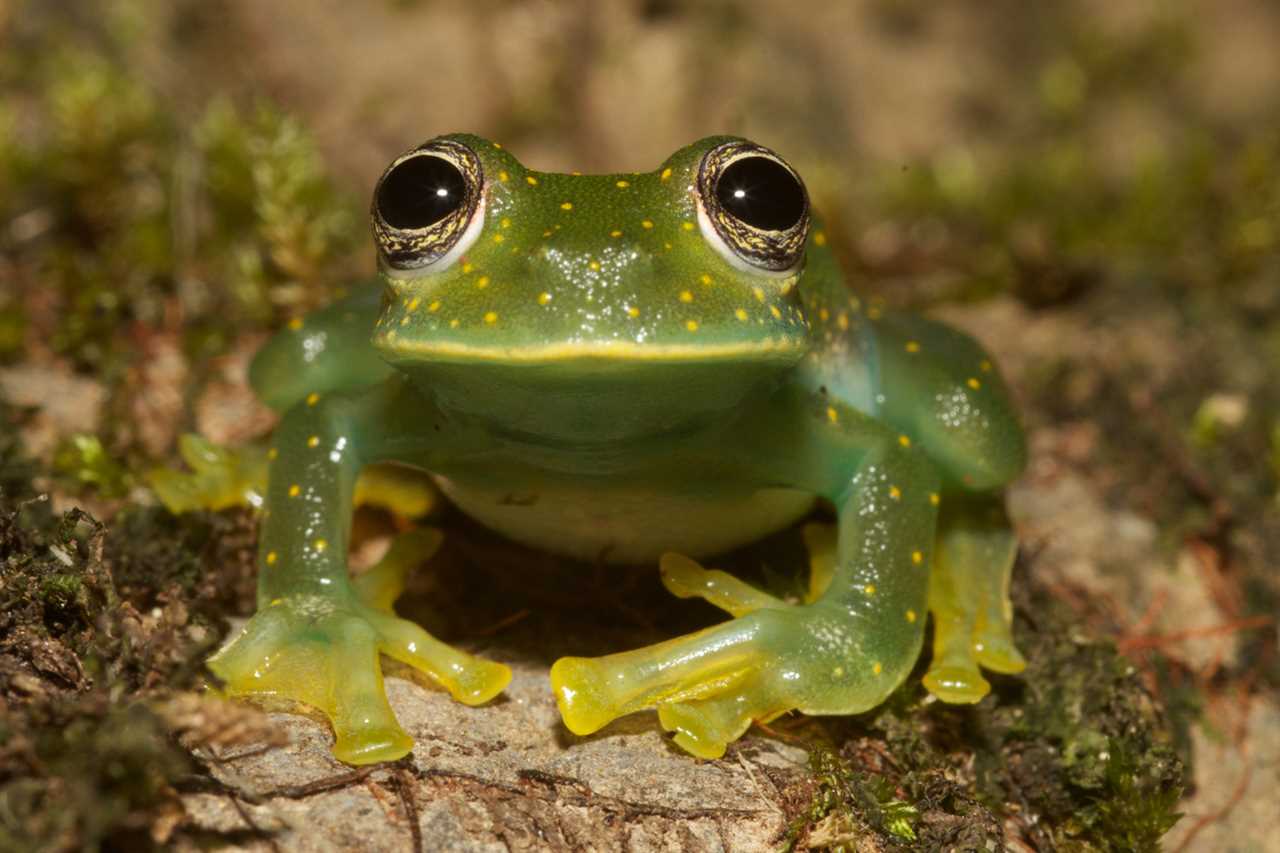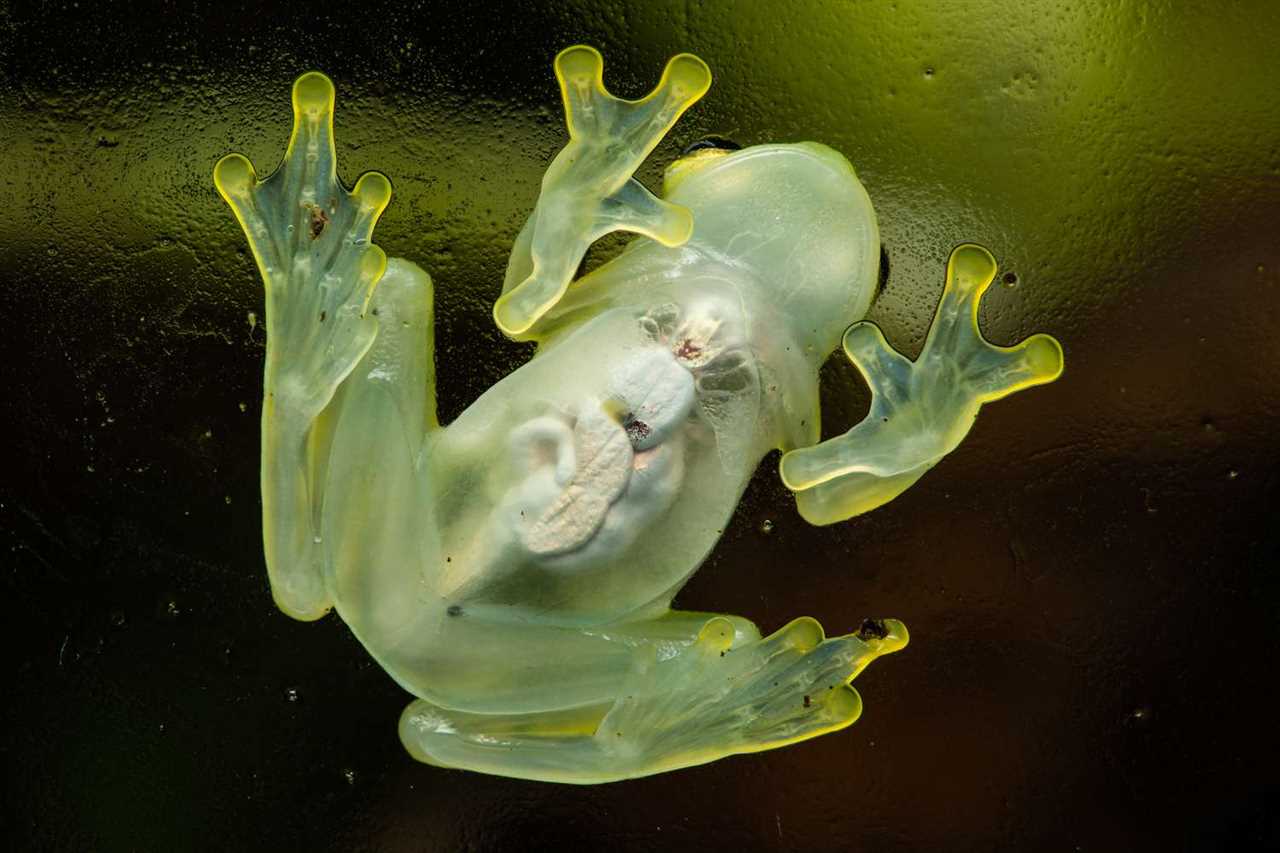Like most frogs, glass frogs are carnivores, which means they primarily feed on other living organisms. However, their diet can vary depending on the species and the size of the frog. In general, glass frogs feed on a wide range of insects, such as ants, beetles, spiders, and flies. They are excellent hunters and use their long, sticky tongues to catch their prey.
One interesting fact about glass frogs is that they are nocturnal, which means they are most active at night. This is the time when they venture out in search of food. Their diet mostly consists of small invertebrates, but some larger species of glass frogs have been known to feed on small vertebrates like small fish and tadpoles.
In summary, glass frogs are carnivorous creatures that primarily feed on insects, but their diet can also include other small invertebrates and occasionally small vertebrates. These unique frogs have adapted to their environment and have developed excellent hunting skills to find their next meal.
The Diet of Glass Frogs
Glass frogs are unique amphibians known for their translucent skin, allowing researchers to observe their internal organs. Along with this remarkable feature, the diet of glass frogs is also intriguing.
These frogs eat a variety of small invertebrates, including insects, spiders, and worms. The primary prey of glass frogs are typically insects, such as ants, beetles, flies, and crickets. They have a preference for soft-bodied insects, but they are not picky eaters and will consume whatever they can find.
What sets glass frogs apart is their feeding behavior. Instead of actively hunting their prey, glass frogs are sit-and-wait predators. They perch on leaves or branches above a water source, waiting patiently for insects to come near. Once an insect is within reach, the frog extends its long, sticky tongue to catch the prey.
This method of feeding is particularly effective at night when insects are more active. The translucent skin of glass frogs also aids in camouflage, making it harder for potential prey to detect them.
As for the quantity of food they consume, glass frogs do not need to eat a large amount. Their metabolism is relatively slow, allowing them to survive on a limited diet. However, they still need to eat regularly to meet their energy requirements.
Overall, the diet of glass frogs consists mainly of insects, which they catch using their unique feeding behavior. Their translucent skin and sit-and-wait hunting strategy make them fascinating creatures to study.
What Do Glass Frogs Eat?
Glass frogs have a unique diet that consists mainly of insects and other small invertebrates. These frogs are primarily carnivorous and rely heavily on their ability to catch and consume a wide variety of prey.
The diet of glass frogs can vary depending on their habitat and the availability of food sources. They are opportunistic feeders and will eat whatever insects are abundant in their environment. Some common prey items include ants, beetles, flies, spiders, and crickets.
Glass frogs have a specialized feeding strategy that allows them to hunt for prey effectively. They have large mouths and sticky tongues that they use to capture and consume their food. They are also known for their excellent vision, which helps them locate their prey even in low light conditions.
Insects as Primary Prey

Glass frogs primarily feed on insects, making them insectivorous animals. Their diet consists mainly of small arthropods such as beetles, ants, spiders, and crickets. These insects provide the necessary nutrients and energy for the glass frogs to survive and reproduce.
The diets of glass frogs can vary depending on their habitat and life stage. Studies have shown that adult glass frogs tend to consume a wider variety of insects compared to their tadpoles. This is because adult glass frogs have a greater ability to capture and consume larger prey.
Specialized Feeding Behavior
This specialized feeding behavior is essential for the glass frog’s survival as it allows them to efficiently capture their prey without expending unnecessary energy. Additionally, their translucent bodies provide them with camouflage, enabling them to remain hidden while waiting for their next meal.
Dietary Adaptations
The glass frog’s diet has been shaped by its unique anatomy and physiology. Their long, slender bodies and long legs allow them to move quickly and navigate through the dense vegetation of their habitat, making it easier for them to hunt for insects.
Furthermore, their large eyes provide them with excellent vision, helping them to locate and track their prey. This visual acuity is especially important at night when glass frogs are most active.
It is worth noting that while insects are the primary prey of glass frogs, they have been observed consuming other small prey such as smaller frogs, snails, and even small fish on rare occasions.
Dietary Adaptations of Glass Frogs
Glass frogs are unique creatures that have developed several dietary adaptations to help them survive in their natural habitats. These adaptations allow them to efficiently find and consume their preferred food sources.
- Camouflage: One of the most notable dietary adaptations of glass frogs is their ability to camouflage themselves. Their translucent skin allows them to blend in with their surroundings, making it easier for them to sneak up on their prey without being noticed.
- Tongue and Jaw Structure: Glass frogs also have specialized tongues and jaw structures that are adapted for capturing and consuming their prey. Their long, sticky tongues can quickly catch insects, while their strong jaws allow them to crush and devour their food.
- Nocturnal Behavior: Glass frogs are primarily nocturnal, meaning they are most active at night. This behavioral adaptation allows them to take advantage of the abundance of insects that are active during this time, ensuring a steady supply of food.
- High Metabolic Rate: Glass frogs have a high metabolic rate, which means they require a lot of energy to sustain their active lifestyle. This adaptation allows them to quickly digest their food and efficiently convert it into energy.
These dietary adaptations have allowed glass frogs to thrive in their natural habitats and become successful predators. They have evolved to be specialized hunters, using their unique characteristics to locate, catch, and devour their prey.
Impact of Diet on Survival

What glass frogs eat can greatly affect their survival in the wild. Diet plays a crucial role in the overall health and fitness of these amphibians. The food choices they make can determine their growth rate, reproductive success, and resistance to diseases.
Glass frogs primarily eat insects, such as ants, beetles, flies, and spiders. This is their main source of nutrition, providing them with the necessary energy and nutrients to survive. Insects are rich in proteins, vitamins, and minerals that help maintain their bodily functions and support their growth.
Different species of glass frogs have specific dietary adaptations that enable them to effectively hunt and consume their prey. For example, some glass frogs have long tongues that they use to snatch insects from leaves or branches. Others have sticky pads on their toes that allow them to grip their prey tightly.
The diet of glass frogs also influences their behavior and habitat selection. For instance, frogs that feed on insects found in fast-flowing streams or water bodies may prefer to live near these habitats. They rely on the abundance of their primary prey and the unique conditions provided by these environments for their survival.
Research has shown that changes in the availability or quality of their food sources can negatively impact glass frog populations. Habitat destruction, pollution, and climate change can lead to the loss of insect populations or alter their distribution, making it harder for glass frogs to find enough food to eat.

I’m Lena Adams—a product of an unconventional upbringing in the African wilderness. My father, a daring explorer of African wildlife, sparked my fascination with reptiles, a passion that intertwined with the tragic loss of my mother during an expedition, leaving an indelible mark on my life. Driven to understand the creatures that captivated my parents, I embarked on my journey, sharing insights about reptiles, frogs, and lizards on my website. Through my explorations and conservation efforts, I honour my family’s legacy while seeking connections—to the creatures, nature, and the mother whose presence I yearn to understand.
